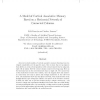Free Online Productivity Tools
i2Speak
i2Symbol
i2OCR
iTex2Img
iWeb2Print
iWeb2Shot
i2Type
iPdf2Split
iPdf2Merge
i2Bopomofo
i2Arabic
i2Style
i2Image
i2PDF
iLatex2Rtf
Sci2ools
BCEC
1997
1997
Attractor Network Models of Cortical Associative Memory
Attractor network models of cortical associative memory functions have developed considerably over the past few years. Here we show that we can improve them further, in terms of correspondence with cortical connectivity, by using multiple cells in lamina II/III of cortical columns connected by long-range
bers as the functional unit in the network instead of just a single cell. The connectivity of the model then becomes more realistic, since the original dense and symmetric connectivity now may be sparse and strongly asymmetric at the cell-to-cell level. Our simulations show that this kind of network, with model neurons of the Hodgkin-Huxley type arranged in columns, can operate as an associative memory in much the same way as previous models having a simpler connectivity. Cell activities comply with experimental
ndings and reaction times are within biological and psychological limits. By introducing a scaling model we make it plausible that a network approaching experimentally repor...
Applied Computing | Attractor Network Models | BCEC 1997 | Cortical Associative Memory | Cortical Connectivity |
| Added | 01 Nov 2010 |
| Updated | 01 Nov 2010 |
| Type | Conference |
| Year | 1997 |
| Where | BCEC |
| Authors | Anders Lansner, Erik Fransén |
Comments (0)

